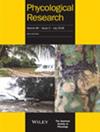暴露在锌和过氧化氢中的布拉蛙的即时反应
IF 1
4区 生物学
Q2 MARINE & FRESHWATER BIOLOGY
引用次数: 1
摘要
在短时间暴露实验中,分析了锌(Zn)和过氧化氢(H2O2)对灰蝶的直接影响。暴露浓度分别为12.3、18.4和24.5μmol L−1 H2O2、12、60和120 mg L−1 Zn和12.3μmol L–1 H2O2 + 12 mg L−1 Zn,12.3μmol L−1 H2O2 + 60 mg L−1 Zn和18.4μmol L−1 H2O2 + 12 mg L−1锌。通过测定光合光系统II活性、叶绿素a和b以及类胡萝卜素含量、H2O2浓度以及抗坏血酸过氧化物酶、过氧化氢酶和愈创木酚过氧化物酶的抗氧化酶活性,分析了braunii的胁迫反应。锌的短期添加降低了braunii的色素含量。暴露于H2O2的braunii中的叶绿素a、b和类胡萝卜素含量与对照植物一样高。H2O2处理的braunii C.光合作用降低,短期添加Zn不会影响电子传输速率。在对照和暴露植物之间,braunii的H2O2浓度和抗氧化酶活性没有显著差异。描述了酶适应的趋势:H2O2诱导的应激反应的特征是抗氧化酶活性增加,而锌灭活了braunii中的过氧化氢酶。本文章由计算机程序翻译,如有差异,请以英文原文为准。
Immediate response of Chara braunii exposed to zinc and hydrogen peroxide
The immediate effect of zinc (Zn) and hydrogen peroxide (H2O2) in Chara braunii was analyzed in short‐time exposure experiments. The exposure concentrations were 12.3, 18.4, and 24.5 μmol L−1 H2O2, 12, 60, and 120 mg L−1 Zn, and 12.3 μmol L−1 H2O2 + 12 mg L−1 Zn, 12.3 μmol L−1 H2O2 + 60 mg L−1 Zn, and 18.4 μmol L−1 H2O2 + 12 mg L−1 Zn. The stress response of C. braunii was analyzed by measuring photosynthetic photosystem II activity, chlorophyll a and b and carotenoid contents, the H2O2 concentration, and antioxidant enzyme activities of ascorbic peroxidase, catalase, and guaiacol peroxidase. The short‐term addition of Zn reduced pigment contents in C. braunii. Chlorophyll a and b and carotenoid contents in H2O2‐exposed C. braunii were as high as in control plants. Photosynthesis was reduced in H2O2‐treated C. braunii and the short‐term addition of Zn did not affect the electron transport rate. H2O2 concentration and antioxidant enzyme activities in C. braunii were not significantly different between control and exposed plants. Trends of enzymatic adaptation were described: the H2O2‐induced stress response was characterized by increased antioxidant enzyme activities, whereas Zn inactivated catalase in C. braunii.
求助全文
通过发布文献求助,成功后即可免费获取论文全文。
去求助
来源期刊

Phycological Research
生物-海洋与淡水生物学
CiteScore
3.60
自引率
13.30%
发文量
33
审稿时长
>12 weeks
期刊介绍:
Phycological Research is published by the Japanese Society of Phycology and complements the Japanese Journal of Phycology. The Journal publishes international, basic or applied, peer-reviewed research dealing with all aspects of phycology including ecology, taxonomy and phylogeny, evolution, genetics, molecular biology, biochemistry, cell biology, morphology, physiology, new techniques to facilitate the international exchange of results. All articles are peer-reviewed by at least two researchers expert in the filed of the submitted paper. Phycological Research has been credited by the International Association for Plant Taxonomy for the purpose of registration of new non-vascular plant names (including fossils).
 求助内容:
求助内容: 应助结果提醒方式:
应助结果提醒方式:


